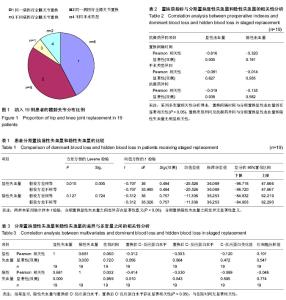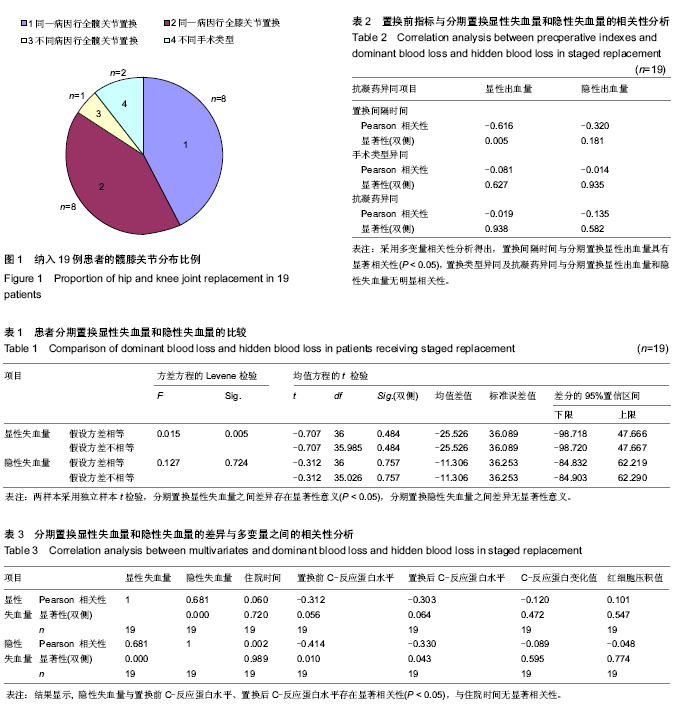Chinese Journal of Tissue Engineering Research ›› 2014, Vol. 18 ›› Issue (48): 7732-7738.doi: 10.3969/j.issn.2095-4344.2014.48.005
Previous Articles Next Articles
Comparison of perioperative blood loss in the same patient undergoing staged joint replacement
Yuan Lei, Bao Ni-rong, Zhao Jian-ning
- Department of Orthopedics, Nanjing General Hospital of Nanjing Military Area Command of Chinese PLA, Clinical College of Medical School of Nanjing University, Nanjing 210002, Jiangsu Province, China
-
Received:2014-10-10Online:2014-11-26Published:2014-11-26 -
Contact:Zhao Jian-ning, Chief physician, Professor, Doctoral supervisor, Department of Orthopedics, Nanjing General Hospital of Nanjing Military Area Command of Chinese PLA, Clinical College of Medical School of Nanjing University, Nanjing 210002, Jiangsu Province, China -
About author:Yuan Lei, Studying for master’s degree, Department of Orthopedics, Nanjing General Hospital of Nanjing Military Area Command of Chinese PLA, Clinical College of Medical School of Nanjing University, Nanjing 210002, Jiangsu Province, China -
Supported by:The Special Science and Technology Project of Clinical Medicine in Jiangsu Province, No. BL2012002
CLC Number:
Cite this article
Yuan Lei, Bao Ni-rong, Zhao Jian-ning. Comparison of perioperative blood loss in the same patient undergoing staged joint replacement[J]. Chinese Journal of Tissue Engineering Research, 2014, 18(48): 7732-7738.
share this article

2.1 参与者数量分析 按意向性处理,纳入19例患者,全部进入结果分析,无脱落。19例患者髋膝关节分布比例 见图1。 2.2 患者分期2次置换显性失血量和隐性失血量的分析 见表1。 2.3 置换前指标与分期置换显性失血量和隐性失血量的相关性分析 见表2。 2.4 分期置换显性失血量和隐性失血量的差异与多变量之间的相关性分析 见表3。 纳入患者分期置换前血红蛋白和红细胞压积值均维持在正常范围,差异无显著性意义。对多个变量的相关性进行秩相关和多重线性分析,结果提示,关节置换后存在严重的隐性失血,与个体本身相关,与其他外界变量无直接相关性。置换后C-反应蛋白值的变化与红细胞压积值的变化呈现同步性。"

| [1] Foss NB, Kehlet H. Hidden blood loss after surgery for hip fracture.J Bone Joint Surg. 2006;88(8): 1053-1059. [2] Pattison E,Protheroe K,Pringle RM,et al. Reduction in haemoglobin after knee joint surgery. Ann Rheum Dis. 1973; 32(6):582. [3] Sehat KR, Evans RL, Newman JH. Hidden blood loss following hip and knee arthroplasty correct management of blood loss should take hidden loss into account. J Bone Joint Surg. 2004;86(4): 561-565. [4] Liu X, Zhang X, Chen Y, et al. Hidden blood loss after total hip arthroplasty. J Arthroplasty. 2011;26(7): 1100-1105. [5] 张波,庞清江,章海均,等.全膝关节置换术后隐性失血的研究进展[J].中国骨伤, 2012,28(9):788-792. [6] Tai TW,Chang CW,Yang CY,et al. Effects of tourniquet use on blood loss and soft-tissue damage in total knee arthroplasty: a randomized controlled trial. J Bone Joint Surg Am. 2012; 94(24):2209-2215. [7] 郑杰,高迪,贾斌,等.老年全髋置换患者术后隐性出血与生存质量关系的对照研究[J].中国中医急症, 2013, 22(7):1135-1136. [8] 陈虎,曹力,杨德盛,等.麻醉方式与全膝关节置换术后深静脉血栓发生率分析[J].中国矫形外科杂志,2012,20(5):402-405. [9] 吴川,王秀丽.髂筋膜间隙阻滞在老年股骨粗隆间骨折麻醉中的应用[J].实用医学杂志,2012,28(20):3416-3417. [10] 高玉镭,王东辰,李佩佳,等.人工全髋关节置换术隐性失血量的估算及原因分析[J].实用医药杂志,2012,29(6):490-492. [11] Jiang X,Hand AR, Shen S, et al. Enhanced tissue plasminogen activator synthesis by the sympathetic neurons that innervate aging vessels. J Neurosci Res. 2003;71(4): 567-574. [12] 刘志刚,张上上,陈如见,等.全髋关节置换后的隐性失血[J].中国组织工程研究,2013,17(13):2305-2312. [13] Prasad N,Padmanabhan V,Mullaji A. Blood loss in total knee arthroplasty:an analysis of risk factors.Int Orthop. 2007; 31: 39-44. [14] 罗涛,黄伟杰,吴伟,等.肥胖对半髋关节置换术围手术期失血的影响[J].中国矫形外科杂志, 2011,19(17):1419-1422. [15] Bell TH, Berta D, Ralley F,et al. Factors affecting perioperative blood loss and transfusion rates in primary total joint arthroplasty: a prospective analysis of 1642 patients. Can J Surg. 2009;52(4):295-301. [16] Yeager AM, Ruel AV, Westrich GH. Are bilateral total joint arthroplasty patients at a higher risk of developing pulmonary embolism following total hip and knee surgery? JArthroplasty. 2014; 29(5): 900-902. [17] Niki Y, Katsuyama E, Takeda Y, et al. Comparison of Postoperative Morbidity Between Simultaneous Bilateral and Staged Bilateral Total Knee Arthroplasties: Serological Perspective and Clinical Consequences. JArthroplasty. 2014; 29(3): 504-509. [18] Lindberg-Larsen M, Joergensen CC, Husted H, et al. Simultaneous and staged bilateral total hip arthroplasty: a Danish nationwide study. Arch Orthop Trauma Surg. 2013 ; 133(11): 1601-1605. [19] Ishii Y, Noguchi H, Takeda M, et al. Length of hospital stay with patient-dependent determination in bilateral scheduled staged total knee arthroplasty. Eur J Orthop Surg Traumatol. 2014;24(6):961-965. [20] Bini SA, Khatod M, Inacio M, et al. Same-Day Versus Staged Bilateral Total Knee Arthroplasty Poses No Increase in Complications in 6672 Primary Procedures. J Arthroplasty. 2014;29(4): 694-697. [21] Alosh H, Shah RP, Courtney PM, et al. One-Week Staged Bilateral Total Knee Arthroplasty Protocol: A Safety Comparison of Intended and Completed Surgeries. J Arthroplasty. 2014;29(6): 1176-1180. [22] 朱斌杰,陈哲峰,刘锋,等.同期和分期全膝关节置换术治疗双膝关节骨关节炎的安全性与疗效[J].中华骨科杂志,2014,34(6): 619-623. [23] 周一新.骨科标准新突破手术技术指导规范-《人工髋、膝关节置换术》解读[J].中国卫生标准管理,2011,2(4): 72-74. [24] Guan M, Wang J, Zhao L, et al. Management of hip involvement in ankylosing spondylitis. Clin Rheumatol. 2013;32(8): 1115-1120. [25] Ward CF, Meathe EA, Benumof JL, et al. A computer nomogram for blood loss replacement. Anesthesiology. 1980;53: 126-130. [26] Gross JB. Estimating allowable blood loss: corrected for dilution. Anesthesiology. 1983;3: 277-280. [27] Nadler SB,Hidalgo JU,Bloch T. Prediction of blood volume in normal human adults. Surgery. 1962;57: 224-232. [28] Erskine JG, Fraser C, Simpson R, et al. Blood loss with knee joint replacement. J R Coll Surg Edinb. 1981;26(5): 295-297. [29] McManus KT, Velchik MG, Alavi A, et al. Non-invasive assessment of postoperative bleeding in TKA patients with Tc-99m RNCs. J Nuclear Med. 1987;28(8): 565-567. [30] Faris PM,Ritter MA,Keating EM,et al. Unwashed filtered shed blood collected after knee and hip arthroplasties. J Bone Joint Surg. 1991;73:1169-1178 [31] Bao N, Zhou L,Cong Y,et al. Free fatty acids are responsible for the hidden blood loss in total hip and knee arthroplasty. Med Hypotheses. 2013;133(1)104-107. [32] Prasad N,Padmanabhan V,Mullaji A.Blood Loss in Total Knee Arthroplasty:an analysis of risk factors. Int Orthop. 2007; 31(1):3944. [33] Bertz A, Indrekvam K, Ahmed M, et al. Validity and reliability of preoperative templating in total hip arthroplasty using a digital templating system. Skeletal Radiol. 2012. [34] Delavenne X, Frappé P, Zufferey P, et al. PK evaluation of fondaparinux sodium for the treatment of thrombosis. Expert Opin Drug Metab Toxicol. 2014;10(2): 269-277. [35] Gómez-Outes A, Terleira-Fernández AI, Suárez-Gea ML,等. 达比加群酯,利伐沙班或阿哌沙班与依诺肝素用于全髋关节或膝关节置换术后的血栓预防:系统综述,荟萃分析和间接治疗比较[J].中华关节外科杂志(电子版),2013,7(6):96-102. [36] 孙伟,史冬泉,庞勇,等.全髋关节置换术后速碧林或拜瑞妥抗凝治疗对隐性失血量的影响[J].中国骨与关节损伤杂志,2013, 28(2): 136-137. [37] Alosh H, Shah RP, Courtney PM, et al. One-Week Staged Bilateral Total Knee Arthroplasty Protocol: A Safety Comparison of Intended and Completed Surgeries. J Arthroplasty. 2014;29(6): 1176-1180. [38] Bini SA, Khatod M, Inacio M, et al. Same-Day Versus Staged Bilateral Total Knee Arthroplasty Poses No Increase in Complications in 6672 Primary Procedures. J Arthroplasty. 2014;29(4): 694-697. [39] Fu D, Li G, Chen K, et al. Comparison of clinical outcome between simultaneous-bilateral and staged-bilateral total knee arthroplasty: a systematic review of retrospective studies. J Arthroplasty. 2013;28(7): 1141-1147. [40] Rahman WA, Garbuz DS, Masri BA. Total hip arthroplasty in steroid-induced osteonecrosis: early functional and radiological outcomes. Can J Surg. 2013;56(1): 41. [41] Scherer MA,Neumaier M,Von Gumppenberg S. C-reactive protein in patients who had operative fracture treatment. Clin Orthop. 2001;393:287-293. [42] Miyamae Y, Inaba Y, Kobayashi N, et al. Different diagnostic properties of C-reactive protein, real-time PCR, and histopathology of frozen and permanent sections in diagnosis of periprosthetic joint infection. Acta Orthopaedica. 2013; 84(6): 524-529. [43] Thienpont E, Grosu I, Jonckheere S, et al. C-reactive protein (CRP) in different types of minimally invasive knee arthroplasty. Knee Surg Sports Traumatol Arthrosc. 2013;21(11):2603-2610. doi: 10.1007/s00167-012-2345-3. [44] Laiho K, Mäenpää H, Kautiainen H, et al. Rise in serum C reactive protein after hip and knee arthroplasties in patients with rheumatoid arthritis. Ann Rheum Dis. 2001;60(3): 275-277. [45] Milone MT, Kamath AF, Israelite CL. Converting between high-and low-sensitivity C-reactive protein in the assessment of periprosthetic joint infection. J Arthroplasty. 2014;29(4): 685-689. [46] Battistelli S, Fortina M, Carta S, et al. Serum C-Reactive Protein and Procalcitonin Kinetics in Patients Undergoing Elective Total Hip Arthroplasty. Bio Med Res Int. 2014. |
| [1] | Chen Ziyang, Pu Rui, Deng Shuang, Yuan Lingyan. Regulatory effect of exosomes on exercise-mediated insulin resistance diseases [J]. Chinese Journal of Tissue Engineering Research, 2021, 25(25): 4089-4094. |
| [2] | Chen Yang, Huang Denggao, Gao Yuanhui, Wang Shunlan, Cao Hui, Zheng Linlin, He Haowei, Luo Siqin, Xiao Jingchuan, Zhang Yingai, Zhang Shufang. Low-intensity pulsed ultrasound promotes the proliferation and adhesion of human adipose-derived mesenchymal stem cells [J]. Chinese Journal of Tissue Engineering Research, 2021, 25(25): 3949-3955. |
| [3] | Yang Junhui, Luo Jinli, Yuan Xiaoping. Effects of human growth hormone on proliferation and osteogenic differentiation of human periodontal ligament stem cells [J]. Chinese Journal of Tissue Engineering Research, 2021, 25(25): 3956-3961. |
| [4] | Sun Jianwei, Yang Xinming, Zhang Ying. Effect of montelukast combined with bone marrow mesenchymal stem cell transplantation on spinal cord injury in rat models [J]. Chinese Journal of Tissue Engineering Research, 2021, 25(25): 3962-3969. |
| [5] | Gao Shan, Huang Dongjing, Hong Haiman, Jia Jingqiao, Meng Fei. Comparison on the curative effect of human placenta-derived mesenchymal stem cells and induced islet-like cells in gestational diabetes mellitus rats [J]. Chinese Journal of Tissue Engineering Research, 2021, 25(25): 3981-3987. |
| [6] | Hao Xiaona, Zhang Yingjie, Li Yuyun, Xu Tao. Bone marrow mesenchymal stem cells overexpressing prolyl oligopeptidase on the repair of liver fibrosis in rat models [J]. Chinese Journal of Tissue Engineering Research, 2021, 25(25): 3988-3993. |
| [7] | Liu Jianyou, Jia Zhongwei, Niu Jiawei, Cao Xinjie, Zhang Dong, Wei Jie. A new method for measuring the anteversion angle of the femoral neck by constructing the three-dimensional digital model of the femur [J]. Chinese Journal of Tissue Engineering Research, 2021, 25(24): 3779-3783. |
| [8] | Meng Lingjie, Qian Hui, Sheng Xiaolei, Lu Jianfeng, Huang Jianping, Qi Liangang, Liu Zongbao. Application of three-dimensional printing technology combined with bone cement in minimally invasive treatment of the collapsed Sanders III type of calcaneal fractures [J]. Chinese Journal of Tissue Engineering Research, 2021, 25(24): 3784-3789. |
| [9] | Qian Xuankun, Huang Hefei, Wu Chengcong, Liu Keting, Ou Hua, Zhang Jinpeng, Ren Jing, Wan Jianshan. Computer-assisted navigation combined with minimally invasive transforaminal lumbar interbody fusion for lumbar spondylolisthesis [J]. Chinese Journal of Tissue Engineering Research, 2021, 25(24): 3790-3795. |
| [10] | Hu Jing, Xiang Yang, Ye Chuan, Han Ziji. Three-dimensional printing assisted screw placement and freehand pedicle screw fixation in the treatment of thoracolumbar fractures: 1-year follow-up [J]. Chinese Journal of Tissue Engineering Research, 2021, 25(24): 3804-3809. |
| [11] | Shu Qihang, Liao Yijia, Xue Jingbo, Yan Yiguo, Wang Cheng. Three-dimensional finite element analysis of a new three-dimensional printed porous fusion cage for cervical vertebra [J]. Chinese Journal of Tissue Engineering Research, 2021, 25(24): 3810-3815. |
| [12] | Wang Yihan, Li Yang, Zhang Ling, Zhang Rui, Xu Ruida, Han Xiaofeng, Cheng Guangqi, Wang Weil. Application of three-dimensional visualization technology for digital orthopedics in the reduction and fixation of intertrochanteric fracture [J]. Chinese Journal of Tissue Engineering Research, 2021, 25(24): 3816-3820. |
| [13] | Sun Maji, Wang Qiuan, Zhang Xingchen, Guo Chong, Yuan Feng, Guo Kaijin. Development and biomechanical analysis of a new anterior cervical pedicle screw fixation system [J]. Chinese Journal of Tissue Engineering Research, 2021, 25(24): 3821-3825. |
| [14] | Lin Wang, Wang Yingying, Guo Weizhong, Yuan Cuihua, Xu Shenggui, Zhang Shenshen, Lin Chengshou. Adopting expanded lateral approach to enhance the mechanical stability and knee function for treating posterolateral column fracture of tibial plateau [J]. Chinese Journal of Tissue Engineering Research, 2021, 25(24): 3826-3827. |
| [15] | Zhu Yun, Chen Yu, Qiu Hao, Liu Dun, Jin Guorong, Chen Shimou, Weng Zheng. Finite element analysis for treatment of osteoporotic femoral fracture with far cortical locking screw [J]. Chinese Journal of Tissue Engineering Research, 2021, 25(24): 3832-3837. |
| Viewed | ||||||
|
Full text |
|
|||||
|
Abstract |
|
|||||